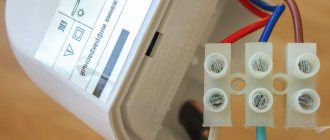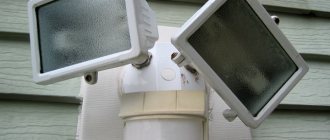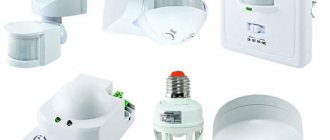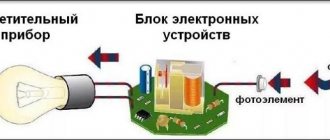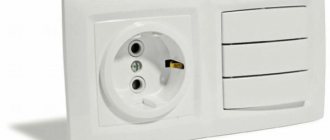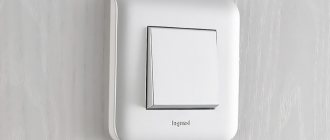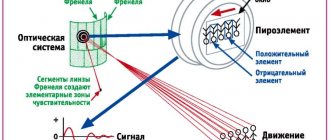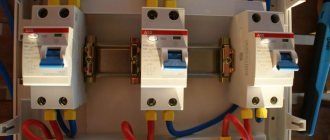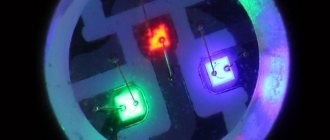The joint operation of a motion sensor and a lamp increases the level of comfort in a home, apartment and even office. The lighting turns on automatically when a person enters the room. When the room is empty, the light automatically goes out, which is an additional energy saving. To connect a motion sensor to a light bulb, the article presents installation diagrams, basic connection rules and operating principles that even novice electricians can understand.
Main functions and operating principle
The motion sensor is designed to detect a moving object and send a corresponding signal to the control body through switching the electrical circuit. Works with active and active-inductive loads in the circuit.
If movement is detected in the controlled area, the light detection process chain starts (if the sensor supports this function). When readings are below the set response threshold, the contacts close, current is supplied to the lamp and the lamp lights up.
According to this principle, the sensor is ready to work in the dark and during daylight hours. The response threshold is set by regulators in the range of 3-2000 Lux.
But a motion sensor can work on a different principle: capturing electromagnetic oscillations of waves in the infrared spectrum. At the same time, sensors often have an adjustable delay to turn on when motion is detected
The shutter speed mode is set by turning the knob. In this case, the delay for operation can be different for everyone: from 10 seconds to 15 minutes.
At the same time, there is no need to buy a finished product in the form of a lamp with a sensor. It is enough to purchase a sensor suitable for this role and include it in the electrical circuit.
Setting up the light sensor
In addition, the photo relay has its own sensitivity adjustment. You can manually set one or another trigger threshold.
That is, the flashlight will work in complete darkness at night, or in the evening, when it is just beginning to get dark.
On popular photo relay models from IEK FR-601 and FR-602, the regulator is located at the base and rotates in the range from “+” to “-”.
If you turn it to the maximum “+”, the photo relay will operate at dusk or in bad weather (cloudy sky). According to the technical characteristics, this adjustment corresponds to approximately 50 Lux.
If you move it to the extreme “-” position, the sensor will only work in complete darkness (illuminance 5 Lux).
It is usually set to the middle position.
These twisters are quite delicate and break easily if too much force is used. So be careful, especially when adjusting sensitivity in cold weather.
At the same time, pay attention to an important nuance.
Mistake #1
The photo relay should be configured outdoors, not indoors.
The sensor is always supplied with a black bag to check its functionality. They covered the device cap with it - the relay worked.
So, in many models, sensitive photocells located inside the case can react, in addition to illumination, to ultraviolet radiation from the sun's rays.
At home, due to glazing, 80% of UV rays are extinguished, but not on the street. Therefore, setting up at home with the creation of artificial darkening may differ from the real outdoor setting.
When there isn't enough range, some get creative and use foil for additional adjustment. The sensor is wrapped with it (fully or halfway), and thereby achieves an initially larger dimming value.
Two-wire connection of a motion sensor
Regardless of the design, motion sensors are divided into two-wire and three-wire based on the connection method.
By design, two-wire ones are usually placed in socket boxes. Basic elements for connection:
- Automatic switch for electrical appliances from a 220V network (usually located in the distribution panel).
- Junction box (usually recessed into the wall/ceiling).
- Motion Sensor.
- Lamp.
The sensor connection is the same as for a single-key switch for artificial lighting. That is, the phase through which the current will flow must be brought to the sensor, and passed through it further to the lamp. In this case, it is recommended to install it on a separate circuit and install it on general lighting.
Installation
The installation process goes like this:
- Lead the three-core cable VVGng-Ls 3*1.5 mm2 from the circuit breaker panel into the distribution box. Mark the conductors for convenience: L (phase), N (working zero), protective zero or ground (PE).
- Lead the two-core wire (extension cord) from the other side into the junction box, first connecting it to the sensor on the other side through the terminal blocks.
- It is recommended to place the motion sensor (if it is a socket box) at a level of 1.2 - 2 meters from the floor level.
- Such sensors should not be confused with wall sensors, which are placed at the entrance, in corridors or in the entrances of a multi-story building. Those used for lighting are usually installed under the ceiling near the doors.
- The viewing level should not be blocked by moving objects (open doors or curtains).
- Also lead the cable from the lamp into the distribution box. First connect the power supply + lamp. Then ground the first and second cable together.
- Connect phase (L) from the circuit breaker to the first core. Connect the second wire to phase (L) of the lamp. For high-quality and aesthetic connections, it is recommended to use Wago terminals.
- The sensor is connected in the socket box according to the following diagram: the first wire (which comes from the machine) is connected to the socket marked (L).
- The second core is inserted into the socket marked “load”.
- Hide the connected sensor in the socket box and put on the structure housing.
Settings
The electrical connection is complete. Now you should configure the sensor on the front panel:
- Turn the first knob to set it to auto mode.
- The second regulator is responsible for sensitivity to light. To activate the sensor only in the dark, turn the control the required number of degrees to the left.
- Timer to turn off lighting when there is no movement in the controlled area. The time range is usually indicated in the device characteristics in the operating instructions.
Ready. At the switchboard, turn the circuit breaker to the "on" position and check the work you just did.
Advantages
Among the positive aspects of this scheme are:
- Easy installation and step-by-step configuration;
- Versatility;
- Automatic switching on of light without installing additional switches;
- Interchangeability with single-key switch.
Flaws
A significant disadvantage of a two-wire sensor is poor interaction with LED and energy-saving lamps. The latter can flicker quite strongly, which, in addition to discomfort, increases the possibility of rapid burnout.
Common errors during installation
The most common mistakes made when installing a motion sensor are:
- lighting equipment is located next to the motion sensor, leading to malfunctions;
- the viewing angle does not cover part of the territory, which is why the light turns on only once;
- a heater or air conditioner is located in the control zone, the air flows of which affect correct operation;
- There is a bulky object in front of the sensor, which significantly narrows the viewing angle.
Three-wire motion sensor connection diagram
Three terminal sensors are typically used in IR sensor type designs. A fairly common manufacturer of inexpensive infrared motion sensors is IEK. You can find good products on Aliexpress without any problems.
More expensive products are made according to a similar principle; the connection diagram for a lamp with a sensor is similar for a sensor model from any manufacturer. Devices must have a degree of protection IP44 against penetration of solid objects greater than 1 mm and drops of moisture. If the motion sensor needs to be moved outside the house, then installation is only possible under a canopy.
If you want to protect the device from rain and snow, look for a model with IP65 dust and moisture protection and a temperature rating for your climate. Most IR sensors can only operate down to minus 20 degrees Celsius.
To connect a three-wire IR motion sensor, a full phase and zero are started. For correct placement you will need the same basic 4 elements:
- Circuit breaker (which is in the switchboard).
- Distribution box (in which the main installation).
- Sensor (a wire from the junction box is connected to it).
- Lamp (second wire from the junction box).
The sensor is connected with three wires to the factory in the distribution box of three cables:
- There are three wires from the machine: L (phase), N (working zero), protective zero or ground (PE).
- There are three wires per lamp if the body of the lighting fixture is made of metal.
- Three wires per sensor.
How to connect a motion sensor to a light bulb using three wires is discussed in detail in the diagram.
The zeros (N) are collected at one point (as in the case of the previous diagram). The ground from the circuit breaker is also connected to the luminaire ground (zero drive or PE). The motion sensor with three terminals is now supplied with phase-zero:
- Two input ones are for 220V power supply, usually labeled as L (phase) and N (zero).
- One output is designated by the letter A.
Installation
To install a three-wire motion sensor:
- Unscrew the two screws in the housing. The terminals are located under the back cover.
- Some models are already led out of the housing by three wires of different colors. By color you can determine what it means: ground (A) red, zero (N) blue, phase (L) brown. But if the cover opens without much effort, it is recommended to verify the correctness of certain markings in person by looking at the inscriptions next to the terminals.
- A simplified diagram of connecting a motion sensor to a light bulb looks like this:
- A little clarity in this picture.
- You can do without a junction box for connecting wires and run all the wires directly into the sensor box, if the inside is spacious enough and has its own terminal block. Phase-zero was supplied from one cable, and phase-zero was removed from the other.
- The result is a simplified, but the same three-wire circuit, only without a junction box.
Setting and adjusting sensitivity
After successfully connecting a lamp with a motion sensor, you need to set its parameters correctly:
- On the back of the case, find the main controls. LUX with the positions of the month and the sun is responsible for triggering depending on the illumination. Do you need the sensor to turn on in a room with a window only when it is cloudy or the sun goes down? Turn the regulator towards the moon.
- Use the second regulator to set the shutdown time. The delay can be set from a few seconds to 5-10 minutes.
- The rotation angle of the entire sphere allows you to adjust the detection of animals.
Advantages and nuances of use
To prevent the sensor from reacting to animals, do not turn the sensor head down towards the floor. Position it so that it captures the movements at the level of the head (shoulders) of all residents of the house. Typically, animal capture does not occur at this level.
If you need the sensor to temporarily not work, then point its head at the ceiling. Therefore, motion capture is not possible. The sensor's motion capture depends on the angle of inclination. In reality, the maximum distance reaches 9 meters. But according to the passport it may be higher.
The sensor uses infrared rays for detection. If you move from beam to beam, the device notices activity and reacts. When you walk directly into the beam, the sensitivity of the sensor is minimal and the device may not immediately respond to you.
For this reason, motion sensors are installed not directly above the doorway, but slightly to the side. For example, in the corner of the room.
Flaws
The disadvantage of the three-wire circuit for connecting the motion sensor to the lamp is that the light does not turn on forcibly. If the sensor malfunctions for some reason, problems will begin with its correct operation. To avoid this, it is recommended to add a switch to the circuit.
Varieties
The division of motion sensors for turning on lights into types is carried out according to several criteria. Based on their operating principle, they can be divided into:
- Infrared - based on measuring the temperature of objects falling within the coverage area of the motion sensor. The main disadvantage is a false reaction to elements of the heating system or incandescent lamps located in close proximity.
2. Infrared sensor Ultrasonic – operate based on the Doppler effect. The emitted sound wave in the frequency range from 20 to 60 kHz is not audible to the human ear in accordance with clause 2.1.1.3 of GOST R 50030.5.2-99. When faced with an obstacle, ultrasound is reflected and returns to the receiver, which sends a signal to an electronic key or relay.
Rice. 3. Ultrasonic sensor
Microwave - use a special antenna that sends a high-frequency signal into the surrounding space. When a signal collides with a moving object, a reflected signal is generated that returns to the sensor. Today these are the most sensitive, but also the most expensive models for turning on the light.
Rice. 4. Microwave sensor
- Laser - usually consist of an LED and a photodiode mounted in the controlled area. The LED emits a signal that spreads into the surrounding space. As soon as an object appears in the area of action that blocks the light flow, it is reflected and perceived by the photodiode. From which the signal is supplied to the actuator of the motion sensor.
- Tomographic - use radio waves to diagnose space. Unlike other models, they are able to penetrate walls, structural elements and other obstacles. Used to turn on lighting in large areas, shopping centers, etc.
Depending on the method of interaction with moving objects, motion sensors can be active, passive or combined . Active ones independently emit measured signals, and then perceive them. Passive ones are focused on the human body’s own radiations or are driven by their interaction with the environment. Combined ones consist of an active emitter installed on one side and a passive receiver located on the other side.
Depending on the installation location, motion sensors are divided into devices for external and internal use . The first ones are intended for use outdoors. The latter are used for placement indoors, sometimes under canopies, on verandas, covered terraces and patios.
Scheme for connecting a motion sensor with a switch
This circuit is considered universal, because it uses a single-key switch.
Since the switch has two wires, and the sensor has three, there is a great way for this - parallel connection:
- Connect the phase from the automatic power supply simultaneously to the switch and the sensor (Wago terminals help).
- Connect the second wire from the one-key switch to the output wire from the sensor (again using Wago terminals).
This circuit will allow you to turn the lighting in the room on and off, regardless of the operation of the motion sensor. Even if it breaks down temporarily, you will not be left without lighting at the right time.
The serial connection (a phase break occurs before the sensor) in this circuit has a significant flaw - completely de-energizing the motion sensor resets its original settings, to which it returns within 20 seconds. Imagine a situation where you turn on the light, stand in the dark, wave your hands in front of the sensor, but it does not react in any way to these movements. The comfort of such a gadget disappears instantly.
Device Specifications
Technical characteristics are indicated in the technical documentation (in the passport) that accompanies any technical product, otherwise it is unlikely that it will be possible to select the necessary device.
Viewing angle
There are products with different viewing angles, both in the vertical and horizontal planes. If it is necessary to protect an object from different sides, then sensors with a viewing angle of up to 360 degrees are used. If the sensor is mounted on a wall, a device with a viewing angle of 180 degrees is sufficient. If you plan to install the sensor on a pole, then it is better to give preference to a viewing angle of 360 degrees. In this case, it all depends on what area and what object or group of objects is planned to be protected. When installed in an apartment, to protect individual rooms, sensors with a smaller viewing angle, about 90 degrees, are chosen.
Depending on the installation location and the required detection zone, select the viewing radius
If there is one entrance to the room, it is enough to install a sensor with a narrow viewing angle, otherwise you have to install several sensors with a narrow viewing angle or one sensor with a wide viewing angle. It should be remembered that such sensors are not cheap, so you should always focus on economic feasibility.
There is also such a thing as vertical viewing angle. In simple, inexpensive models, this figure is no more than 20 degrees. For more expensive models, this figure is much higher and can be all 180 degrees. Such devices are used in security systems where such costs are justified. In lighting systems, the simplest and cheapest device is sufficient. The main thing is that the sensor is installed at the desired height and turns on the lighting under certain conditions.
Radius of action
The range of action should be selected with a margin.
The choice of a motion sensor in terms of range depends on where it will be installed: outdoors or indoors. For indoor use, devices with a range of about 5-7 meters are sufficient. If the sensor is installed in a yard or other location, certain factors must be taken into account, otherwise false alarms may occur. Sensors with a long range can be triggered when people move along the street, when a neighbor appears in their yard, etc. Therefore, in such cases, it is better to opt for devices with a minimum range.
Power of connected lighting sources
Each sensor is designed for a certain load power, which it can turn on/off without emergency modes. Otherwise, the device will simply fail because the controls will not withstand it.
Recently, this indicator is not so critical, since people are switching to more economical lamps, such as energy-saving or diode.
Mounting method and choice of installation location
Motion sensors may also differ in the method of mounting. Therefore there are:
- Case products, in the form of a small box with a bracket. Such models are attached:
- On the ceiling.
- On the wall.
- Built-in models designed for hidden installation.
Such models are distinguished by the fact that they are small in size, which allows them to be installed unnoticed by others.
If you just need to turn on/off the lighting in the right place, then you can get by with cheaper cabinet-mounted devices. Miniature built-in sensors are more suitable for security systems, especially since they are also expensive.
Additional features
Some models, depending on the purpose and operating conditions, have additional functions. These functions include:
- Sensitivity threshold. It is implemented using a light sensor, in the form of a photo relay. This sensor is especially useful when installing the device outdoors. This function is necessary to ensure that the device turns on the lighting only at night.
- Protection from animals. Naturally, in every private yard there are cats and dogs. The function is necessary in order to reduce the number of false alarms when animals move. If there is a large dog in the yard, this function may not work.
For many, a useful feature would be protection against triggering when animals appear. - Shutdown delay. There are different devices, both with and without delay. In most cases this function is adjustable. It is quite inconvenient if a person often moves within the sensor’s coverage area, but also often leaves it, and the motion sensor also often turns the lighting on and off.
Connecting a three-wire sensor to two wires
A fairly common question is: can a three-wire sensor be connected not in parallel with a switch, but instead of a single-key switch. Essentially, remove it from the circuit and allow it to break into phases, as in the case of a two-wire circuit.
Theoretically, this trick can actually work with some lamps. But for this you will need additionally:
- Diode VDI 1N4007;
- Capacitor 2.2 MKF at 400V.
The diode must be installed between the two terminals A-output from the sensor and where zero N is connected. The capacitor itself must be soldered parallel to the light bulb in the lamp. According to the diagram, it turns out that one phase arrives at the sensor, enters contact L and leaves contact N. Output A apparently remains unconnected.
The scheme is popular among residents of houses where a two-core power cable is laid and they do not want to change anything in this direction.
Flaws
The disadvantages are the following:
- Doesn't work with all LED bulbs.
- The pulsation can be so high that it causes enough discomfort, creating additional strain on the eyes.
- You cannot add any other load to the circuit, because nothing else will work here.
- The maximum power of this lighting is 80W.
A visual step-by-step process of connecting a flashlight to a photo relay on a regular stand
The connection diagram for a light sensor for street lighting in a small area will be described below. To do this, we need a lamp, previously screwed into the socket, and the photo relay itself.
For greater clarity, we will install it on a stand. To do this, we attach a light sensor and a lamp in a socket next to each other, which will symbolize the lamp.
Next, you should connect the zero and input phases to the light sensor itself (as a rule, the connection points are marked on the body).
By inserting special rubberized plugs into these holes, you can connect the wires. These rubber plugs provide good protection from dust and other harmful external influences.
“Expert tip”: the connection points of the input wires should be directed downward when installing the sensor, which will increase protection from moisture and dust.
Before connecting, we clean the ends of the wires well (about 1 cm).
Next, connect the wires to the sensor in the following sequence:
- input phase;
- zero phase;
- protective phase (grounding).
The wires are connected to the lighting fixture itself in a similar way. We connect the input and zero phases to the socket, and the grounding phase is connected to the body of the device for lighting.
The last step will be to adjust the sensitivity of the regulator of our photosensor. This completes the installation process; all that remains is to replace the protective cover and tighten the bolts.
This is what the entire procedure for connecting a light sensor and lighting device to an electrical circuit looks like. It is not anything complicated, you just need to follow the correct order of connecting the wires. Otherwise, you can get negative consequences, including a short circuit or even a fire.
The procedure for connecting a photo relay for street lighting to diode light sources or spotlights is similar to that described above and is not particularly difficult.
Circuit with two sensors
If you need to illuminate a long, L-shaped or other type of room, you will need to install several sensors to capture motion. To avoid using extra meters of cables, connect both devices in parallel.
In this scheme, the number of connected sensors is not limited.
It works according to this principle:
- We stepped onto the threshold of a long corridor with a corner turn and the light automatically came on.
- We reached the activation zone of the second sensor - the lighting did not stop.
- Turned 90 degrees and your movement was caught by the third sensor. The coverage is still ongoing.
- After leaving the corridor completely, the lighting stops.
Best models
The best manufacturers of motion sensors for turning on lights are: Rev Ritter, Orbis, Camelion. The TOP 3 best motion sensors for lighting include:
- Orbis 360 degrees CIRCUMAT PRO CR white DU OB134912. A Spanish-made sensor with a detection angle of 360°, operating from a 220 V network. It can operate in a wide temperature range: from –10 to +40°C. Suitable for large spaces because the detection radius is up to 30m.
- Camelion LX-28A 6438. Designed for indoor use. Installed on the ceiling. The shutdown range is from 5 seconds to 9 minutes. What’s important is that the device is not expensive at all.
- Rev Ritter "Action"110. Economical compact LED IR sensor. Installed on a wall or ceiling. Works great and has an attractive price. However, the range is small.
A correctly selected and configured motion sensor guarantees energy savings and ease of use. Sensors can be used in a smart home system to turn lights on/off and as elements of a security system.
Circuit with starter or contactor
The previous connection diagrams are designed for loads within one kilowatt. But there is an alternative type of lighting with powerful loads, for example, sodium arc tube lamps. Or a large load is required to run the fans in the hood along with the lighting.
In this case, a circuit with a starter is used (the load passes through the contacts of the starter). And Sensor-IR in this circuit controls the contactor coil.
The energized output contact from the sensor will energize the coil. Zeros are combined into one common one.
Main conclusions
You can connect a motion sensor for apartment or street lighting either with or without a switch. To install it, it is better to use a three-core colored cable. There are three different schemes:
- With one device without a switch.
- A similar option, but with the placement of a switching device.
- With several parallel connected detectors.
Upon completion of the installation procedures, the sensor must be connected and configured according to the time of illumination attenuation after the cessation of movement, according to sensitivity to the volume of the object and range, as well as to the sensitivity of the photocell to the onset of darkness. After adjusting and turning on the sensor, it is necessary to check its installation - by viewing angle and range. During operation, problems often arise in the operation of the device due to faulty wiring, burnt-out lamps, and initially incorrect choice of location for its installation.
Operational problems or connection errors
Problems with motion sensors include:
- Connecting phase and neutral. According to the operating logic of the device, it does not matter where the zero and phase are connected. But for safety reasons, the break should be located precisely on the conductor connected to the phase. An analogy for such inclusion can be given with a lamp socket.
- False positives. Possible if the sensors are positioned incorrectly, installation near warm or heating elements, installation outdoors, near tree leaves or other extraneous factors.
- Unreasonable activation immediately after deactivation. If a lamp or other light-emitting device is directed at the photorelay of the sensor, this will cause this behavior of the device. A nearby lamp with an incandescent lamp, which does not go out immediately when turned off. The sensor can detect IR waves and start the lighting activation chain. Cases of an endless cycle of activation by IR waves cannot be excluded.
- Mounting the motion sensor on the wall, although according to the passport it is ceiling mounted. It’s not for nothing that the technical specifications indicate the mounting option (wall/ceiling). This has to do with the design of the diagrams. Such devices have different viewing angles and, as a result, problems arise if installed incorrectly.
- Glare and air currents. Factors such as glare and strong air currents cause the IR sensor to react. If a similar situation with glare is discussed in the third paragraph, then with wind things are different. Installation directed towards windows, split systems, or outdoors where there is a strong draft is not recommended.
- Cracks or contamination on the sensitive element when connected to the spotlight. This element in the sensor is the Freckel lens. It is needed to focus IR radiation using concave segment mirrors located inside. If there is a lot of dirt or a crack appears in the front, this means that the device is not working properly.
Finding a place to install
As the installation height increases, the detection zone increases, but the sensitivity decreases.
To ensure that there are as few false alarms as possible, the motion sensor must be placed correctly. In this case, it is necessary to take into account the following points:
- There should be no additional, much less constant, light source in the sensor’s coverage area.
- There should be no heating or heating devices, as well as air conditioners, in the coverage area, otherwise the sensor will act on warm air flows.
- There should be no bulky items or objects that could block the sensor’s coverage area.
When motion sensors are installed indoors, they try to place them close to the ceiling. If you need the sensor to react to any movement in the room, then the sensor is placed in the center of the room. If it is necessary to monitor a specific zone, then the installation location is chosen so that there are no “dead zones” to which the sensor does not respond.
